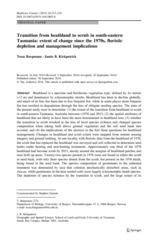| dc.contributor.author | Bargmann, Tessa | eng |
| dc.contributor.author | Kirkpatrick, Jamie B. | eng |
| dc.date.accessioned | 2015-03-10T10:13:50Z | |
| dc.date.available | 2015-03-10T10:13:50Z | |
| dc.date.issued | 2015-02 | eng |
| dc.identifier.issn | 0960-3115 | en_US |
| dc.identifier.uri | https://hdl.handle.net/1956/9491 | |
| dc.description.abstract | Heathland is a speciose and floriferous vegetation type, defined by its stature (<2 m) and dominance by scleromorphic shrubs. Heathland has been in decline globally, and much of its loss has been due to less frequent fire, while in some places more frequent fire has resulted in degradation through the loss of obligate seeding species. The aims of the present study were to determine: (1) the extent of the transition from heathland to scrub in south-eastern Tasmania, Australia between c1976 and 2013; (2) the spatial attributes of heathland that are likely to have been the most instrumental in heathland loss; (3) whether the transition to scrub resulted in the loss of local species richness and changed species composition when taking both above ground vegetation and the soil seed bank into account; and (4) the implications of the answers to the first three questions for heathland management. Changes in heathland and scrub extent were mapped from remote sensing imagery and ground truthing. At one locality with floristic data from the heathland of 1976, the scrub that has replaced the heathland was surveyed and soil collected to determine seed banks under heating and non-heating treatments. Approximately one third of the 1976 heathland had become scrub by 2013, mostly around the margins of heathland patches and near built up areas. Twenty-two species present in 1976 were not found in either the scrub or seed bank, with only three species absent from the scrub, but present in the 1976 heath, being found in the seed bank. The species composition of germinates in the unheated treatment was dominated by taxa that colonise mechanically disturbed areas, such as Juncus, while germinates in the heat treated soils were largely scleromorphic heath species. The depletion of species richness by the transition to scrub, and the large extent of its incidence, suggest that a higher frequency of planned fire is needed in south-eastern Tasmania. | en_US |
| dc.language.iso | eng | eng |
| dc.publisher | Springer | en_US |
| dc.relation.ispartof | <a href="http://hdl.handle.net/1956/10465" target="_blank">BLife after fire: the impact of fire on species composition and diversity in coastal heathlands</a> | en_US |
| dc.rights | Attribution CC BY | eng |
| dc.rights.uri | http://creativecommons.org/licenses/by/4.0 | eng |
| dc.subject | Biodiversity conservation | eng |
| dc.subject | Landscape change | eng |
| dc.subject | Fire | eng |
| dc.subject | Heat shock | eng |
| dc.subject | Prescribed burning | eng |
| dc.subject | Germination | eng |
| dc.subject | Australia | eng |
| dc.title | Transition from heathland to scrub in south-eastern Tasmania: extent of change since the 1970s, floristic depletion and management implications | en_US |
| dc.type | Peer reviewed | |
| dc.type | Journal article | |
| dc.date.updated | 2015-03-03T10:36:52Z | en_US |
| dc.description.version | publishedVersion | en_US |
| dc.rights.holder | Copyright 2014 The Authors | en_US |
| dc.identifier.doi | https://doi.org/10.1007/s10531-014-0803-6 | |
| dc.identifier.cristin | 1160811 | |
| dc.source.journal | Biodiversity and Conservation | |
| dc.source.40 | 24 | |
| dc.source.14 | 2 | |
| dc.source.pagenumber | 213-228 | |
| dc.subject.nsi | VDP::Mathematics and natural scienses: 400::Zoology and botany: 480::Vegetation history: 495 | en_US |
| dc.subject.nsi | VDP::Matematikk og naturvitenskap: 400::Zoologiske og botaniske fag: 480::Vegetasjonshistorie: 495 | nob |

